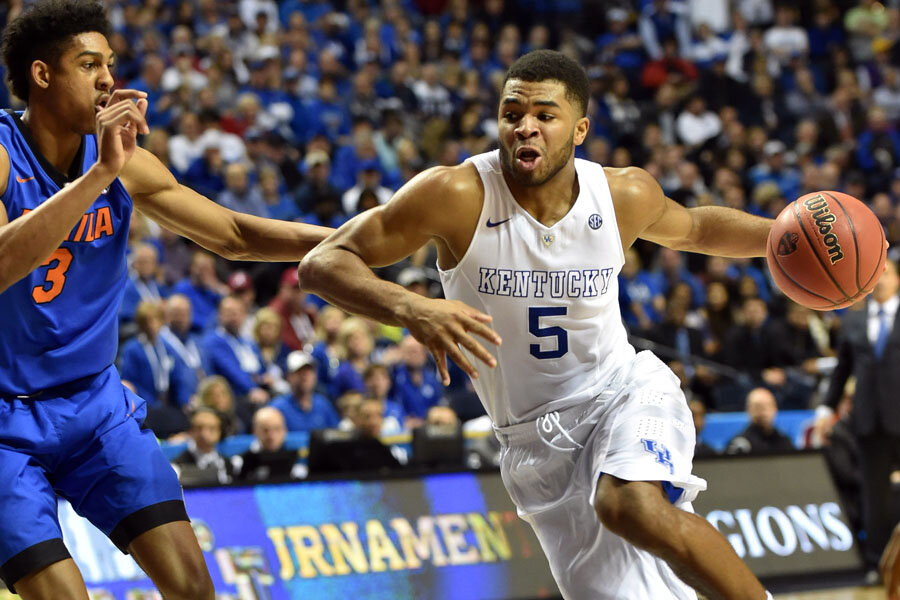March Madness 2015: Time to fill out those NCAA basketball tournament brackets
Loading...
| Boston
With Sunday’s NCAA men’s basketball tournament selection program now upon us, the inevitable discussions of where teams stand in the bracket are heating up. After the program, that begins Sunday night at 6 p.m. Eastern time on CBS, millions of fans will start filling out their brackets in the hope that they will choose the ultimate winner from the remaining four teams, who will meet in Indianapolis next month to decide the national champion.
The biggest “target” this year is the undefeated Kentucky Wildcats (32-0, as of Friday afternoon), who will likely receive the number one overall seed. As of this moment, the other three number ones will probably include the Virginia Cavaliers (29-2), the Duke Blue Devils (29-3), and the Villanova Wildcats (30-2). With the so-called “power conference” tournaments entering their semifinal rounds, this could change; but the body of work each of these teams has put in over the season virtually guarantees they will head up the four regions within the bracket (East, West, Midwest and South).
The tournament consists of 68 Division 1 NCAA teams, with four so-called “play-in” games (two among the four lowest, or 16th seeds, and two involving the four 11th seeded contenders). Though the conference tournaments that immediately precede “March Madness” can determine seeding, they can also determine who gets into the tournament. Winners of the power conference championships, as well as those from twenty smaller conferences (for example, the Patriot League, won by Lafayette College, and the Southern Conference, won by Wofford), receive automatic bids for the 12th through the 16th seeds, as do the top 25 highest ranked teams in the country.
One of the greatest challenges for the NCAA selection committee that determines those teams receiving “at large” bids for the remaining slots is to weigh a potpourri of complex statistics that include strength of schedule (SOS) and the Ratings Percentage Index (RPI). “Bubble” or borderline teams are closely scrutinized and discussed, and perceived “snubs” of those schools excluded from the “Madness” quickly become the obsession of partisan fans and analysts alike, and spread like wildfire on social media—only fueling the excitement and passion that the annual “Big Dance” is well-known for.
Typically, power conference teams outlast their smaller foes; although in recent years, “mid-major” squads such as Butler University from the Horizon League, the Wichita State Shockers from the Missouri Valley Conference, and Virginia Commonwealth University from the Atlantic 10 Conference have all made “Final Four” appearances.
Over the past several seasons, some of the more intriguing matchups in the brackets have been between 12 and 5 seeds. Since 1985, when the tournament expanded to 64 teams, there have been 44 incidents of 12th seeds upsetting their higher-seeded opponents. The matchups are typically between the most accomplished smaller Division 1 clubs and often a vulnerable higher seed. These pairings should be watched closely once announced on Sunday.
Also during the past few seasons, there has been furious activity involving teams migrating from smaller conferences to larger ones. Additionally, as of last year, 36 schools joined Division 1. Financial considerations – including revenue and greater visibility from TV broadcasts, and the more robust alumni donations and student applications that often follow – are important factors determining these decisions; but such a phenomenon also has implications for the landscape of the tournament itself. “David and Goliath” matchups such as those between a No. 16 and a No. 1seed (in the history of the tournament, a 16-seed has never beaten a 1) are watched with ever greater interest as the win streak of 1-seeds builds by the year.
The likelihood of one person filling out a perfect bracket from the tournament’s first tip-off to the cutting down of the nets in Indianapolis is infinitesimally small. But, like the swallows returning annually to Capistrano, the yearly salmon run, or Sisyphus continually forever pushing his boulder uphill, college basketball fans will keep dreaming of besting the experts at determining which is the best team in the country.





